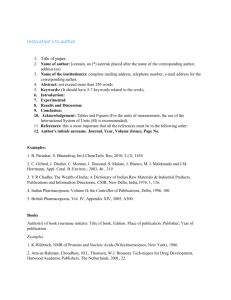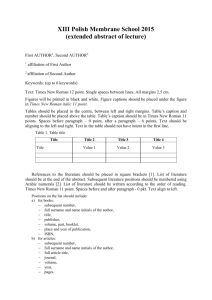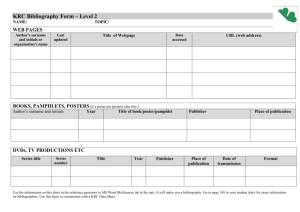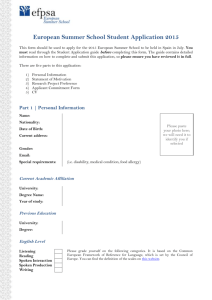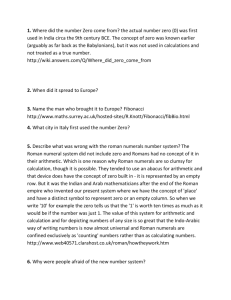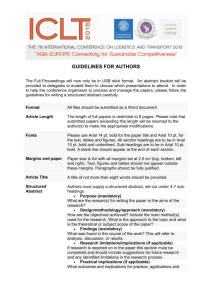Manuscript template - 18th World Congress on Clinical Nutrition
advertisement
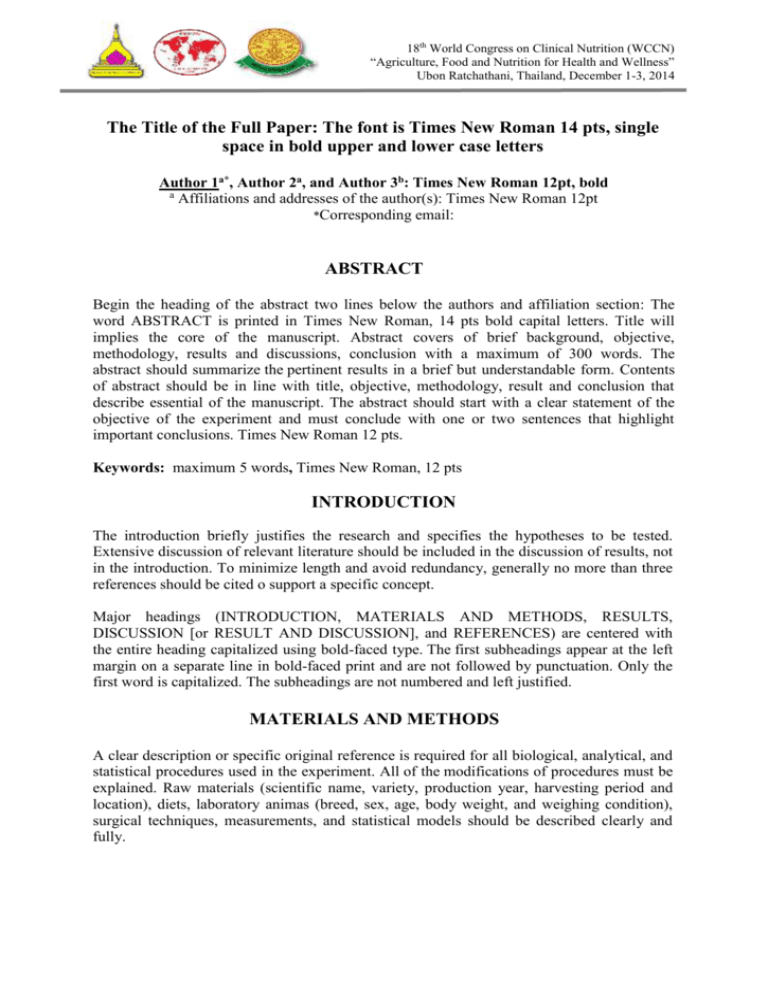
18th World Congress on Clinical Nutrition (WCCN) “Agriculture, Food and Nutrition for Health and Wellness” Ubon Ratchathani, Thailand, December 1-3, 2014 The Title of the Full Paper: The font is Times New Roman 14 pts, single space in bold upper and lower case letters Author 1a*, Author 2a, and Author 3b: Times New Roman 12pt, bold a Affiliations and addresses of the author(s): Times New Roman 12pt *Corresponding email: ABSTRACT Begin the heading of the abstract two lines below the authors and affiliation section: The word ABSTRACT is printed in Times New Roman, 14 pts bold capital letters. Title will implies the core of the manuscript. Abstract covers of brief background, objective, methodology, results and discussions, conclusion with a maximum of 300 words. The abstract should summarize the pertinent results in a brief but understandable form. Contents of abstract should be in line with title, objective, methodology, result and conclusion that describe essential of the manuscript. The abstract should start with a clear statement of the objective of the experiment and must conclude with one or two sentences that highlight important conclusions. Times New Roman 12 pts. Keywords: maximum 5 words, Times New Roman, 12 pts INTRODUCTION The introduction briefly justifies the research and specifies the hypotheses to be tested. Extensive discussion of relevant literature should be included in the discussion of results, not in the introduction. To minimize length and avoid redundancy, generally no more than three references should be cited o support a specific concept. Major headings (INTRODUCTION, MATERIALS AND METHODS, RESULTS, DISCUSSION [or RESULT AND DISCUSSION], and REFERENCES) are centered with the entire heading capitalized using bold-faced type. The first subheadings appear at the left margin on a separate line in bold-faced print and are not followed by punctuation. Only the first word is capitalized. The subheadings are not numbered and left justified. MATERIALS AND METHODS A clear description or specific original reference is required for all biological, analytical, and statistical procedures used in the experiment. All of the modifications of procedures must be explained. Raw materials (scientific name, variety, production year, harvesting period and location), diets, laboratory animas (breed, sex, age, body weight, and weighing condition), surgical techniques, measurements, and statistical models should be described clearly and fully. 18th World Congress on Clinical Nutrition (WCCN) “Agriculture, Food and Nutrition for Health and Wellness” Ubon Ratchathani, Thailand, December 1-3, 2014 RESULTS AND DISCUSSION The result (may be combined with discussion) should be presented in tabular form when feasible. The text should explain or elaborate on the tabular data, but numbers should not be repeated extensively within the text. Sufficient data, all with some index of variation attached, should be presented to allow the reader to interpret the results of the experiment. The discussion (may be combined with results) should interpret the results clearly and concisely. Results and references to the tables and figures already described in the RESULTS section should not be repeated in the DISCUSSION section. Tables: are used to present numerical data in a self-explanatory manner. They should be intelligible without consulting the text and should not duplicate the data already given in the text or in the illustrations. Figures: Please use good quality figures (pictures, graphs) in the paper, color ones as well. The size will not be shrunk during the printing. Please, keep in mind that only the electronic (CD-Rom) publication will be in color (color pictures can be seen there), but the printed version will be grey-scale, so do not use color coding. Figures should be sharp and well readable in the printed proceedings. All of the tables and figures should be cited in the text. Arabic numerals are used to number tables and figures. The table or figure number (i.e. Table 4. Or Figure 4.) is typed in bold face followed by a period. The title of the table or figure continues on the same line with only the first letter capitalized. Do not use a period at the end of the title.The column headings should have the first letter of each word capitalized while the same names of variables are typed with only the first letter capitalized (i.e. Table 1. Title of the table or Figure 1. Title of the figure). For numerals less than 1, insert a zero to the left of the decimal point (columns should be set up so that decimal points are aligned if possible). If there are no data for a particular entry, insert a dash. If an explanation is necessary, use an abbreviation in the body of the table (e.g. ND) and explain clearly in footnotes what the abbreviation means. Care should be taken to ensure that greater accuracy is not implied in the table than is possible from a particular analysis and only significant figures should be used. It is exceedingly rare where accuracy greater than two decimal places are obtained. References to footnotes in a table are specified by superscript numbers, independently for each table. Superscript letters are used to designate statistical significance. Use a lower case p to indicate probability values (i.e. p<0.05). Presentation of pooled standard errors, the general basis for statistical comparisons of means is recommended when variance is homogeneous. These should be presented in a separate column or row. Standard errors can be attached to each mean by ± signs when variance or SE is heterogeneous (e.g. unbalanced experiments or unequal numbers of observations in treatment means). The pooled standard error is the preferred estimate of the experimental error because presenting individual standard errors tends to clutter up the table. Arabic numerals are used to number tables. The table number (i.e. Table 4.) is typed in bold face followed by a period. 18th World Congress on Clinical Nutrition (WCCN) “Agriculture, Food and Nutrition for Health and Wellness” Ubon Ratchathani, Thailand, December 1-3, 2014 Use of numbers: Follow the rules given below for writing numbers. In general, spell out numbers one through nine and use numerals for 10 and above. Use Arabic numerals with abbreviated units of measure: 2 g, 5 d, $4.00, 3% and numerical designations in the text: exp 1, group 3, etc. Use Arabic numerals to express time and date: 08:00 hours, 3 Sept. 1985, etc. In a series using some numbers less than 10 and some more than 10 use numerals for all. When writing a large number ending in several zeros, use a word for part of the number (i.e. 1.8 million rather than 1,800,000). When two numbers appear adjacent to each other, spell out the first (i.e. ten 2-d old rather than 10 2-d old). Do not begin a sentence with a numeral. Spell it out or rearrange the sentence. Use the 24-h clock system: 09:30, 13:40 h, etc. Give day length in quantitative hours (e.g. 2 h 16 min). Abbreviate the terms hour (h), minute (min), second (s) and year (yr) when used with a number in the text but spell them out when they are used alone. Do not use a hyphen to indicate inclusiveness (e.g. use 12 to 14 mg or 3 and 4 not 12-14 mg or 3-4). Table 1. Example of Table Column 1 Column 2 Column 3 Equations are centered and numbered consecutively starting from 1 as follows: C D C 2C D 2 t r r r (1) CONCLUSION This section should represent the summary of the important findings. Conclusions are not an extension of the discussion or a summary of the results without abbreviations, acronyms, or citations. ACKNOWLEDGEMENTS List here those individuals who provided help during the research (e.g., providing research grants, providing research facilities, providing language help, writing assistance or proof reading the article, etc.). REFERENCES References to other publications must be in Harvard style and carefully checked for completeness, accuracy and consistency. This is very important in an electronic environment because it enables your readers to exploit the Reference Linking facility on the database and link back to the works you have cited through CrossRef. You should cite publications in the text: (Adams, 2006) using the first named author's name or (Adams and Brown, 2006) citing both names of two, or (Adams et al., 2006), when there 18th World Congress on Clinical Nutrition (WCCN) “Agriculture, Food and Nutrition for Health and Wellness” Ubon Ratchathani, Thailand, December 1-3, 2014 are three or more authors. At the end of the paper a reference list in alphabetical order should be supplied: For books: Surname, Initials (year), Title of Book, Publisher, Place of publication. e.g. Harrow, R. (2005), No Place to Hide, Simon & Schuster, New York, NY. For book chapters: Surname, Initials (year), "Chapter title", Editor's Surname, Initials, Title of Book, Publisher, Place of publication, pages. e.g. Calabrese, F.A. (2005), "The early pathways: theory to practice – a continuum", in Stankosky, M. (Ed.), Creating the Discipline of Knowledge Management, Elsevier, New York, NY, pp. 15-20. For journals: Surname, Initials (year), "Title of article", Journal Name, volume, number, pages. e.g. Capizzi, M.T. and Ferguson, R. (2005), "Loyalty trends for the twenty-first century", Journal of Consumer Marketing, Vol. 22 No. 2, pp. 72-80. For published conference proceedings: Surname, Initials (year of publication), "Title of paper", in Surname, Initials (Ed.), Title of published proceeding which may include place and date(s) held, Publisher, Place of publication, Page numbers. e.g. Jakkilinki, R., Georgievski, M. and Sharda, N. (2007), "Connecting destinations with an ontology-based e-tourism planner", in Information and communication technologies in tourism 2007 proceedings of the international conference in Ljubljana, Slovenia, 2007, Springer-Verlag, Vienna, pp. 12-32. For encyclopedia entries (with no author or editor): Title of Encyclopedia (year) "Title of entry", volume, edition, Title of Encyclopedia, Publisher, Place of publication, pages. e.g. Encyclopaedia Britannica (1926) "Psychology of culture contact", Vol. 1, 13th ed., Encyclopaedia Britannica, London and New York, NY, pp. 765-71. (For authored entries please refer to book chapter guidelines above) For newspaper: articles (authored) Surname, Initials (year), "Article title", Newspaper, date, pages. e.g. Smith, A. (2008), "Money for old rope", Daily News, 21 January, pp. 1, 3-4. For newspaper articles (non-authored): Newspaper (year), "Article title", date, pages. e.g. Daily News (2008), "Small change", 2 February, p. 7. For electronic sources: If available online, the full URL should be supplied at the end of the reference, as well as a date that the resource was accessed. e.g. Castle, B. (2005), "Introduction to web services for remote portlets", available at: http://www-128.ibm.com/developerworks/library/ws-wsrp/ (accessed 12 November 2007). Standalone URLs, i.e. without an author or date, should be included either within parentheses within the main text, or preferably set as a note (roman numeral within square brackets within text followed by the full URL address at the end of the paper). - See more at: http://www.emeraldgrouppublishing.com/products/journals/author_guidelines.htm?id=nfs#st hash.Ia4jR4Sb.dpuf
